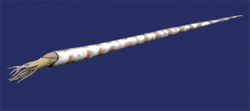Cephalopoda
 Cephalopoda have symmetrical cone-shaped shells with internal partitions called septae. Cephalopoda have symmetrical cone-shaped shells with internal partitions called septae.
A success story during the Ordovician was the diversification of nautiloid cephalopods which are characterized by smoothly curved septa. The animal's body occupied the last chamber while a siphuncle connected it with all the other gas- or fluid-filled chambers through a hole in each wall. By changing the content of gas and fluid, the animal could regulate its buoyancy. They swam by "jet propulsion", taking in water and then ejecting it through the tube. These intelligent carnivorous molluscs with shells up to 10 m long replaced the Cambrian Anomalocarids as the dominant life form and top predator of the world's oceans.
Early forms of straight (orthoconic) chambered shells evolved into forms that were coiled into a flattened spiral with overlapping shell layers, which made the shell stronger, while the even spacing of the chambers improved buoyancy.
|













